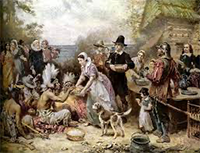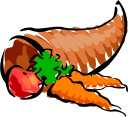The First Thanksgiving
The first Thanksgiving was probably not what we think it was. The Thanksgiving we now celebrate--a feast of togetherness between the Pilgrims and the Native Americans--was not the original gathering.
Rather
it was a celebration of the fall harvest, when vegetables
were pulled from the ground and off stalks and made ready
for a big meal.
Pilgrims and Native Americans dined together at the same tables, yes, and they played games together and demonstrated their bow-and-arrow and musket-shooting skills to each other. But they didn't call it Thanksgiving until 1624. That year, William Bradford, the governor of the Plymouth Colony, proclaimed a day of thanksgiving that was really a day of fasting and prayer. (Remember, fasting is when you don't eat. So, Thanksgiving started out as a day of not eating.) And the day the members of the Plymouth Colony celebrated this day of fasting and prayer in thanksgiving was November 29.
This merged celebration continued informally through the years, until 1863, when President Abraham Lincoln declared the fourth Thursday of November a national holiday called Thanksgiving. How did we decide on eating Turkey? Well, that's another story. |
|
Social Studies for Kids
copyright 2002–2024
David White



 It
is true that
It
is true that 
 So
we have two ideas coming together: a day of thanksgiving for
the fall harvest, on which people fasted and prayed, and a
great feast to celebrate the bounty of the fall harvest.
Since both activities celebrated the same thing--the fall
harvest--it's only natural that they eventually merged (like
so many other American holidays).
So
we have two ideas coming together: a day of thanksgiving for
the fall harvest, on which people fasted and prayed, and a
great feast to celebrate the bounty of the fall harvest.
Since both activities celebrated the same thing--the fall
harvest--it's only natural that they eventually merged (like
so many other American holidays).

